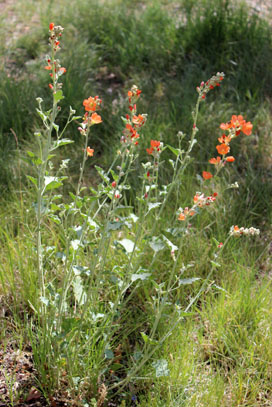Globemallow, 'Louis Hamilton' - Sphaeralcea ambigua 'Louis Hamilton'
Globemallow, Monro's - Sphaeralcea munroana
 |
 |
Food:
"The fruits of all globe-mallows are edible. Their pollen and seeds have been found at Chaco Canyon, Pecos, and on the Rio Grande near Zia and Santa Ana in archaeological contexts, suggesting that they were regularly eaten. In fact, globe-mallow seems to be one of the most widely used plants during this Anasazi era." (Dunmire and Tierney 187)
"The roots were sometimes chewed to reduce hunger when food was scarce." (Kershaw 140)
Medicine
"--- the root was also pounded and mixed with a little saltwater as a poultice to draw infection from sores and boils. A similar use is known for other pueblos: at Santa Clara, globe-mallow may be rubbed on sore muscles (because of the fine, stiff, star-shaped hairs on the foliage, the plant probably irritates the skin and brings blood to the affected area). At Picuris the roots of scarlet globe-mallow (S. coccinea) once were pounded into a pulp, mixed with water, and plastered over broken or fractured bones, solidifying into a hard cast.
Other medicinal properties have been attributed to globe-mallow, but medicine for sore eyes, as in one of its colloquial names, 'sore-eye poppy', is definitely not one of them. This name probably is as result of children having eaten the buds or fruits of the plant and then irritating their eyes by rubbing them with hands covered with the fine but scratchy star-shaped leaf hairs" (Dunmire and Tierney 188)
"At Tularosa, New Mexico, a midwife told me you must boil a small piece of the root in a glass of water to obtain a purge. This must be taken three times a day or before breakfast whenever necessary.
If a decoction of the plant is drunk every morning for nine days, it is supposed to act as a diuretic."(Curtin 189)
"Scarlet globemallow roots were chewed and then laid on sores and wounds to aid healing and stop bleeding. The leaves are slimy and mucilaginous when crushed, and they were chewed or mashed and used as poultices or plasters on inflamed skin, sores, wounds and aching or blistered feet. Leaves were also used in lotions to relieve skin diseases. Dried, ground leaves were dusted on sores or were mixed with water to make a paste for use as a protective, drawing poultice. Fresh leaves and flowers were chewed or made into teas for relieving hoarse or sore throats and upset stomachs. Whole plants were used to make a sweet-tasting tea that made distasteful medicines more palatable. This tea was also said to reduce swellings, improve appetite, relieve upset stomachs and strengthen voices." (Kershaw 140)
"For the Navajo, globemallow is a Life Medicine, useful for treating colds and headache, stimulating the appetite, and settling and upset stomach." Native Americans used the roots to help make casts for broken bones, to stanch bleeding , to soothe teething pain, and to poultice sores and snakebites."(Finley and Nieland 34)
"Several species of Sphaeralcea used by Navajo, Hopi, Tewa and Keres for treatment of colds, sores, snakebite, stomachache, and diarrhea; ..." (Littlefield and Burns 163)
"Used by Navajo as an infusion to stop bleeding, a tonic to cure coughs and colds ..." (Littlefield and Burns 164)
"(Sphaeralcea coccinea) Infusion of plant used for swellings. --- Plant used for pain. --- Chewed plant applied as a cooling and healing salve to sores and wounds." (Moerman 540)
"(Sphaeralcea fendleri) Plant used for sand cricket bites. --- Infusion of plant taken for sore mouth. --- Cold, compound infusion of plant taken for internal injury and hemorrhage. --- Infusion of plant used as lotion for external injury." (Moerman 540)
Other Uses:
"Utilization of this plant definitely has carried over into historical times. The people of Santo Domingo have boiled globe-mallow and added it to gypsum as a glue for calcimine house paint. At Taos the pulp of the plant has been mixed with mud to make very hard floors." (Dunmire and Tierney 187-8)
"Tea made from scarlet globemallow was use as a remedy for diseases caused by witchcraft. ---The fuzzy leaves have been recommended as a soothing shoe-liner." (Kershaw 140)
"Globemallows contain mucilage that soothes or stiffens, depending on the application. The Navajo name 'gummy medicine' acknowledges this sticky property. After washing their hair some Native Americans would rinse it with an infusion of globemallow as a conditioner to add shine and softness. If they desired a stiffer 'hairdo,' they would allow the globemallow infusion to dry in the hair without rinsing it out." (Finley and Nieland 34)
"... as a source of pigment for face paint, as a glue-like substance to hold feathers and cotton on skin during dances or to mix with mud to make floors hard."(Littlefield and Burns 163)